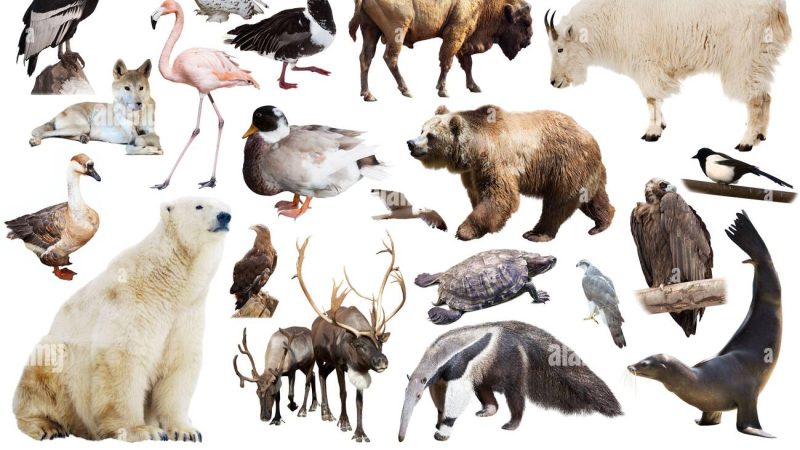The northern wilderness is home to some of the most resilient and awe-inspiring creatures on Earth. From the icy Arctic tundra to the dense boreal forests, North Animals have adapted to extreme temperatures, harsh landscapes, and scarce food supplies. These creatures possess remarkable traits that help them survive in the wild, showcasing nature’s incredible ability to evolve.
In this article, we’ll unveil ten of the most fascinating North Animals, exploring their unique characteristics, habitats, and survival strategies. Whether it’s the stealth of the Arctic fox or the sheer strength of the moose, each of these creatures plays a crucial role in the ecosystem.
Let’s dive into the wild and uncover these extraordinary animals!
The Mighty Polar Bear: King of the Arctic
One of the most iconic North Animals, the polar bear (Ursus maritimus) reigns over the Arctic ice. With its thick fur and a layer of blubber, this powerful predator thrives in freezing temperatures. Polar bears are exceptional swimmers, capable of covering vast distances in search of food, primarily seals.
However, climate change poses a significant threat to these majestic creatures. As Arctic ice melts, their hunting grounds shrink, making survival increasingly difficult. Conservation efforts are crucial to protecting the future of these top predators.
The Elusive Arctic Fox: Master of Camouflage
The Arctic fox (Vulpes lagopus) is a true survivor of the tundra, with its dense fur changing colors from white in winter to brown in summer. This natural camouflage helps it evade predators and sneak up on prey.
Unlike other North Animals, Arctic foxes are known for their incredible endurance, often traveling long distances to scavenge for food. Their keen sense of hearing allows them to detect small mammals beneath thick snow, making them efficient hunters.
The Majestic Moose: The Giant of the North
The moose (Alces alces) is the largest member of the deer family, found in boreal forests across North America, Scandinavia, and Russia. These massive herbivores can stand over 7 feet tall at the shoulder and weigh up to 1,500 pounds.
Despite their size, moose are agile swimmers and can dive underwater to forage for aquatic plants. As one of the most recognizable North Animals, moose play an essential role in maintaining forest ecosystems by controlling vegetation growth.
The Stealthy Wolverine: Fierce and Formidable
The wolverine (Gulo gulo) is a small but ferocious carnivore, known for its unmatched strength and aggressive nature. These solitary hunters inhabit the remote forests and tundras of the northern hemisphere.
Wolverines can take down prey much larger than themselves, including deer and caribou, showcasing their fearless hunting skills. As one of the toughest North Animals, they are well adapted to extreme conditions, often covering vast territories in search of food.
The Snowy Owl: A Silent Hunter of the Tundra
Among the most striking North Animals, the snowy owl (Bubo scandiacus) stands out with its pure white plumage and piercing yellow eyes. These birds are formidable hunters, preying on small mammals like lemmings and hares.
Unlike most owls, snowy owls are diurnal, meaning they hunt during the day. They have incredible patience, often perching motionless for hours before striking their prey with precision. Their ability to thrive in Arctic conditions makes them a true symbol of the north.
The Arctic Hare: Built for the Cold
The Arctic hare (Lepus arcticus) is a resilient creature perfectly adapted to the harsh climate of the tundra. With thick fur, short ears, and powerful hind legs, it can withstand freezing temperatures and evade predators with incredible speed.
These herbivores play a vital role in the Arctic food chain, serving as prey for many other North Animals, including foxes, wolves, and owls. Their ability to survive in extreme cold is a testament to nature’s adaptability.
The Gray Wolf: The Ultimate Pack Hunter
Wolves (Canis lupus) are one of the most well-known North Animals, roaming forests and tundras in packs. As apex predators, they play a crucial role in maintaining ecological balance by controlling prey populations.
Known for their strong social bonds, wolves hunt in coordinated packs, bringing down large animals like moose and caribou. Their haunting howls echo through the wilderness, signaling territory claims and communication within the pack.
The Reindeer: The True Wanderer of the North
Also known as caribou in North America, reindeer (Rangifer tarandus) are famous for their long migrations across vast northern landscapes. These herbivores possess specialized hooves that help them traverse snow and ice with ease.
Reindeer herds can travel up to 3,000 miles in a year, making them one of the most mobile North Animals. Indigenous communities have relied on reindeer for centuries, utilizing them for food, clothing, and transportation.
The Musk Ox: A Relic of the Ice Age
Musk oxen (Ovibos moschatus) are among the oldest surviving North Animals, dating back to the Ice Age. These large, shaggy mammals are built for frigid Arctic conditions, with long, thick fur providing insulation against the cold.
Living in tight-knit herds, musk oxen use defensive formations to protect themselves from predators like wolves. Their strong social bonds and impressive resilience make them one of the most fascinating creatures of the north.
The Lynx: A Silent Predator in the Snow
The lynx (Lynx lynx) is a stealthy, elusive predator that roams the forests of the northern hemisphere. With tufted ears, large padded paws, and a thick coat, the lynx is perfectly adapted to snowy environments.
Unlike other North Animals, lynxes rely on stealth and patience to hunt, often ambushing prey such as hares and small deer. Their solitary nature and remarkable agility make them one of the most mysterious predators of the north.
Conclusion
From the mighty polar bear to the stealthy lynx, North Animals showcase the extraordinary resilience of wildlife in extreme conditions. Each of these creatures has evolved unique adaptations to thrive in harsh northern environments, highlighting nature’s incredible ingenuity.
However, many of these animals face threats from climate change, habitat loss, and human activity. Conservation efforts are crucial to ensuring their survival and maintaining the delicate balance of northern ecosystems.
By appreciating and protecting these remarkable North Animals, we can help preserve the beauty and diversity of the wild for future generations.
FAQs
Q1. Which animals are best adapted to extreme cold?
Animals like the polar bear, Arctic fox, and musk ox have thick fur and fat layers to withstand freezing temperatures, while reindeer and wolves migrate or hunt in packs.
Q2. What are some predators found in the Arctic and boreal forests?
Common predators include polar bears, wolves, lynxes, and wolverines. These animals have specialized hunting skills and adaptations for survival in northern habitats.
Q3. How do Arctic animals find food in the winter?
Many rely on keen senses and survival strategies, such as hunting under the snow, scavenging, or migrating to areas with more abundant food sources during colder months.
Q4. Why do some animals change fur color in different seasons?
Species like the Arctic fox and hare change fur color from white in winter to brown in summer, helping them blend into their surroundings and avoid predators.
Q5. What are the biggest threats to wildlife in northern regions?
Climate change, habitat loss, and human activities like hunting and industrial development pose significant risks, impacting food sources and disrupting ecosystems.
ALSO READ: Pousada Caiman: 10 Luxurious Amenities That Set Us Apart









